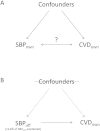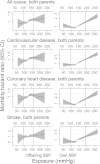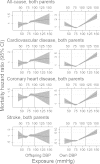Blood pressure and mortality: using offspring blood pressure as an instrument for own blood pressure in the HUNT study
- PMID: 26198310
- PMCID: PMC4510525
- DOI: 10.1038/srep12399
Blood pressure and mortality: using offspring blood pressure as an instrument for own blood pressure in the HUNT study
Abstract
Given that observational associations may be inaccurate, we used offspring blood pressure (BP) to provide alternative estimates of the associations between own BP and mortality. Observational associations between BP and mortality, estimated as hazard ratios (HRs) from Cox regression, were compared to HRs obtained using offspring BP as an instrumental variable (IV) for own BP (N = 32,227 mother-offspring and 27,535 father-offspring pairs). Observationally, there were positive associations between own BP and mortality from all-causes, cardiovascular disease (CVD), coronary heart disease (CHD), stroke and diabetes. Point estimates of the associations between BP and mortality from all-causes, CVD and CHD were amplified in magnitude when using offspring BP as an IV. For example, the HR for all-cause mortality per standard deviation (SD) increase in own systolic BP (SBP) obtained in conventional observational analyses increased from 1.10 (95% CI: 1.09-1.12; P < 0.0001) to 1.31 (95% CI: 1.19-1.43; P < 0.0001). Additionally, SBP was positively associated with diabetes and cancer mortality (HRs: 2.00; 95% CI: 1.12-3.35; P = 0.02 and 1.20; 95% CI: 1.02-1.42; P = 0.03, respectively), and diastolic BP (DBP) with stroke mortality (HR: 1.30; 95% CI: 1.02-1.66; P = 0.03). Results support positive associations between BP and mortality from all-causes, CVD, and CHD, SBP on cancer mortality, and DBP on stroke mortality.
Figures



References
-
- Clausen J. & Jensen G. Blood pressure and mortality: an epidemiological survey with 10 years follow-up. J. Hum. Hypertens. 6, 53–59 (1992). - PubMed
-
- Gu Q., Burt V. L., Paulose-Ram R., Yoon S. & Gillum R. F. High blood pressure and cardiovascular disease mortality risk among U.S. Adults: the third national health and nutrition examination survey mortality follow-up study. Ann. Epidemiol. 18, 302–330 (2008). - PubMed
-
- Fried L. P. et al. Risk factors for 5-year mortality in older adults. JAMA. 279, 585–592 (1998). - PubMed
-
- Satish S., Freeman D. J., Ray L. & Goodwin J. S. The relationship between blood pressure and mortality in the oldest old. J. Am. Geriatr. Soc. 49, 367–374 (2001). - PubMed
-
- Psaty B. M. et al. Association between blood pressure level and the risk of myocardial infarction, stroke, and total mortality: The cardiovascular health study. Arch. Intern. Med. 161, 1183–1192 (2001). - PubMed
Publication types
MeSH terms
Grants and funding
LinkOut - more resources
Full Text Sources
Other Literature Sources
Medical

